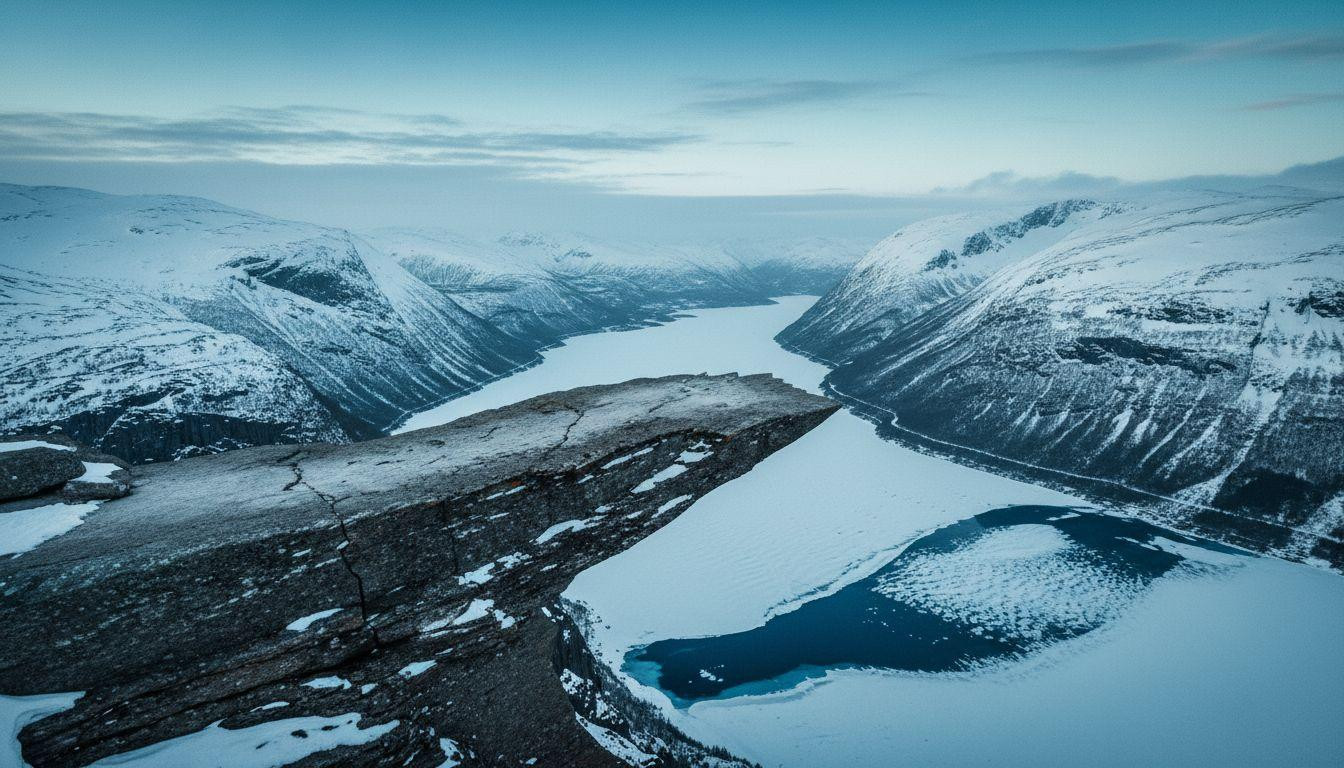At 11:00 AM on a July Saturday, you’re 47th in line for the Trolltunga photo. The queue snakes backward along the narrow rock formation jutting 2,300 feet above turquoise Ringedalsvatnet lake. Sixty minutes later, you get your 30-second Instagram moment before being hurried along.
This isn’t the Norwegian mountain experience. It’s a theme park attraction at 3,870 feet elevation. But what tourism boards won’t tell you: the real Trolltunga exists in November through February, when winter transforms the “highly dangerous, NOT recommended” trail into Norway’s most magical guided expedition.
Forget summer crowds. This is when Trolltunga remembers it’s a mountain, not a photo op.
Why summer Trolltunga became Instagram’s victim
June through September: the narrow four-month window when independent hiking is permitted. Peak season reality brings 60-90 minute photo waits documented by official sources. The 14-mile round-trip hike taking 8-12 hours becomes secondary to queue management.
Parking and shuttle costs reach $50-80 just to start the ordeal. Trail conditions alternate between muddy slopes, steep rocky scrambles, and technical terrain with fixed ropes. Yet crowds make it feel like a congested highway through the wilderness.
Zero facilities exist between the trailhead and destination. No water sources, no restrooms, no vendor stands for 14 miles of hiking. The paradox: dramatic beauty attracts masses, masses destroy the experience that created the attraction.
Those iconic photos exist for a reason. The 700-meter vertical drop above turquoise waters is genuinely spectacular. The problem isn’t the destination. Success killed solitude.
Winter Trolltunga: when “dangerous” means magical
The transformation November brings
Mid-November through mid-February: “NOT recommended” for independent hikers becomes mandatory guided tours. Snow coverage, ice conditions, and 5-6 hours daylight create the change. Temperatures drop to 5-23°F with wind chill making conditions feel significantly colder.
Professional guides provide specialized equipment including crampons, snowshoes, and avalanche safety gear. The numbers that matter: virtually zero photo queues, genuine mountain solitude. Arctic light phenomena create golden hour at 2:00 PM, blue hour by 3:00 PM.
Snow transforms rust-brown landscape into brilliant white punctuated by exposed rock. The turquoise lake below freezes partially, creating otherworldly ice patterns. The famous tongue becomes a snow-dusted platform where you’re alone except for your guide group.
What guides make possible
Expert route-finding through snow-covered terrain where trail markers vanish under winter conditions. Avalanche risk assessment and alternative routing when needed. Emergency shelter knowledge of three mountain refuges: Floren, Endåen, and Tyssehøl.
Equipment provision includes headlamps for pre-dawn starts and comprehensive safety gear. The psychological difference: confidence versus anxiety changes everything about the mountain experience.
Cost reality: winter guided tours cost $110-185, versus summer’s “free” hiking that costs hours in queues and parking fees approaching $75.
The winter experience: what actually happens
Pre-dawn start in Arctic darkness
5:30 AM departure from Skjeggedal trailhead in headlamp-lit darkness. Crampons bite into frozen trail where summer brought ankle-deep mud. The silence: no crowds, no chatter, just breathing and snow crunch underfoot.
First light at 8:00 AM reveals transformed landscape. Brutal cold demands proper gear and creates mental toughness. Temperature management becomes constant: adding and removing layers as exertion and elevation change body heat.
Near this village of 300 where red fishing cabins cling to fjord cliffs 67 degrees north, similar winter transformations occur across Norway’s dramatic landscapes.
The summit moment no queue can buy
Arriving at Trolltunga with your small guide group of typically 6-8 people maximum. The platform empty except for wind and view stretching across frozen fjordland. Guides allow 20-30 minutes because there’s no line behind you.
Photography without pressure: shoot from every angle, experiment with compositions, breathe in the achievement. The earned quality: four hours ascending through winter conditions makes the destination meaningful beyond social media validation.
Like 7 Arctic beaches where white sand rivals Caribbean turquoise for 70% less cost, Norway’s winter landscapes offer experiences unavailable during peak tourism seasons.
Practical realities: is winter worth it?
Winter guided expeditions require exceptional physical fitness. The “Very Demanding” classification applies year-round, but winter adds technical complexity and environmental challenges. Previous winter hiking experience helps but isn’t required since guides manage risk assessment.
Physical preparation for 10+ hours of walking and climbing in cold conditions requires conditioning months before travel. Mental toughness becomes equally important: Arctic cold, limited daylight, and physical exhaustion test resolve consistently.
Current access realities include road closure between P1-P2 through December 13, 2025. Guided tour companies require booking 2-3 months ahead for winter slots. Base accommodation in Odda ranges $65-110 per night for mid-range options.
Total budget reaches $250-350 per person including lodging, professional guide, specialized gear, and meals. The trade-off: higher cost, harder conditions, shorter daylight equals authentic Norwegian mountain experience without crowds that ruined summer hiking.
Consider this Norwegian mining town with UNESCO heritage that costs 40% less as a cultural complement to winter mountain adventures.
Your questions about Trolltunga winter expeditions answered
How dangerous is winter Trolltunga compared to summer?
Paradoxically safer with professional guides despite harsher conditions. Summer sees regular search and rescue operations from unprepared independent hikers. Winter mandatory guidance eliminates most risk factors through proper equipment, route knowledge, and emergency protocols.
What’s the real difference in experience quality?
Summer Trolltunga is a checkbox destination with crowds and queues. Winter becomes a relationship with the mountain: negotiating conditions, respecting weather, earning the view through genuine effort and preparation.
How does this compare to other challenging winter hikes?
Similar to 7 mountain moments across Mount Shasta that redefine California volcanic escapes, winter Trolltunga offers spiritual solitude impossible during peak seasons. Technical difficulty matches advanced alpine routes worldwide.
Summer Trolltunga will still exist when Instagram moves on to the next viral destination. But if you want the mountain experience that made Norway famous before social media, winter guided expeditions offer what summer independent hiking no longer can: solitude, respect, and earned privilege of standing where few dare to go.
